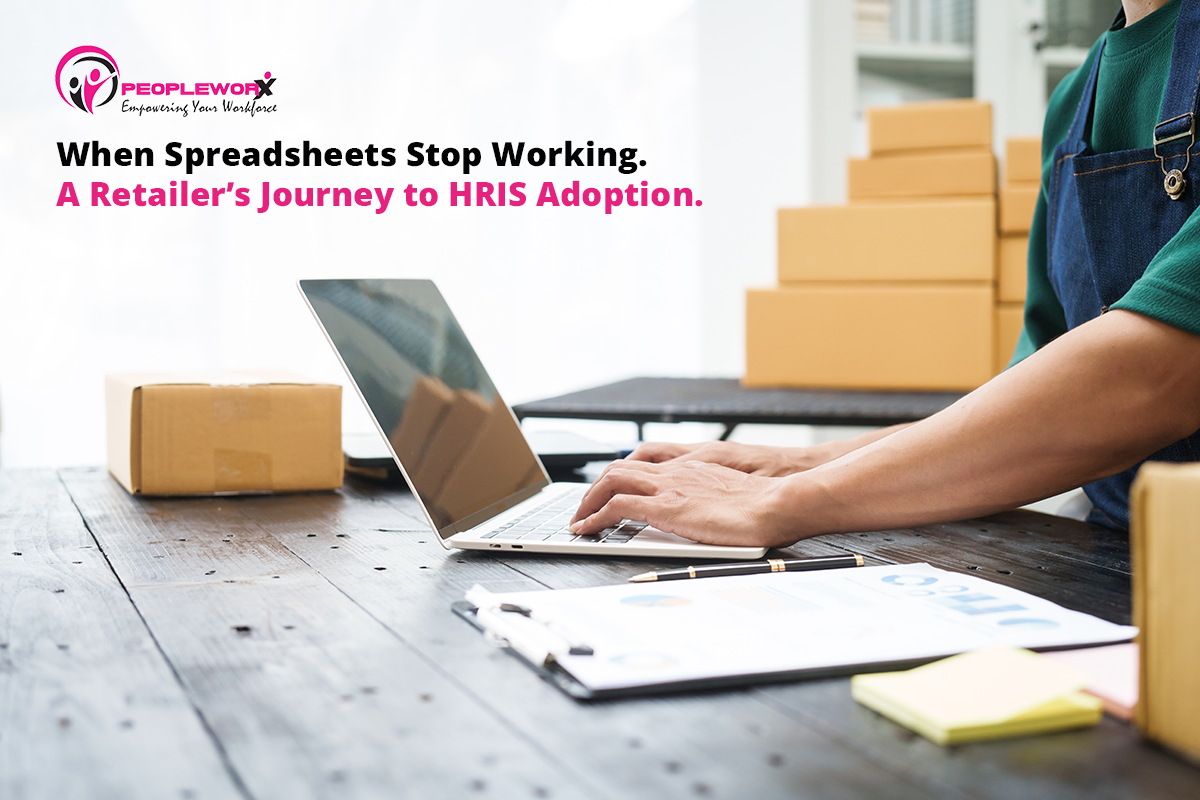When Spreadsheets Stop Working. A Retailer’s Journey to HRIS Adoption.

In this first installment of our HR tech adoption series, we explore how a small, family-run retail business outgrew manual HR processes and took the first step toward digital transformation by implementing a Human Resource Information System (HRIS). From payroll errors and compliance risks to improved onboarding and employee self-service, this real-world narrative illustrates how the right technology, at the right time, can turn growing pains into sustainable growth.
A Growing, Family-run Retail Business: An HRIS Case Study
In the heart of a bustling suburban community, a small, family-run retail business began its journey with a single storefront specializing in artisanal home goods. Fueled by a passion for craftsmanship and personalized customer service, the store quickly became a local favorite. Within two years, buoyed by strong sales and positive customer feedback, the owners seized an opportunity to open a second location in a neighboring town. The expansion was driven by a combination of factors common in retail growth: increased demand, favorable market conditions, and access to funding.
By the fifth year, a third storefront was launched, marking a significant milestone in the company’s growth trajectory. Each new location brought its own set of challenges and learning curves, but the overarching theme was clear: the business was thriving, and the future looked promising.

The HR Growing Pains
However, as the business expanded, the complexities of managing multiple locations began to surface. Initially, administrative tasks were handled manually, employee schedules were created using spreadsheets, payroll was processed through basic accounting software, and personnel records were stored in physical filing cabinets.
As the workforce grew to nearly 40 employees across three locations, these manual processes became increasingly untenable. For instance:
- A manager at one store might approve an employee’s time-off request via email, while another used handwritten notes, leading to inconsistencies and scheduling conflicts.
- Payroll errors became more frequent, with miscalculations in overtime pay and missed deductions causing frustration among staff.
The lack of a centralized system also meant that onboarding new employees was inconsistent. Some new hires received comprehensive training and timely access to necessary resources, while others experienced delays and confusion. These discrepancies not only affected employee morale but also posed compliance risks, especially as labor laws and regulations evolved.
The tipping point came when the business undertook a complimentary HR compliance audit which discovered the following issues:
- Gaps in employee documentation
- Inconsistencies in timekeeping records
- Outdated labor policies
While the issues were not insurmountable, they highlighted the urgent need for a more robust and scalable human resources system.
Recognizing the Need for an HRIS
In the aftermath of the audit, the business owners consulted with their accountant and sought advice from fellow small business owners. The consensus was clear: it was time to invest in a Human Resource Information System (HRIS).
An HRIS is a software platform that centralizes and automates core HR functions. It is typically the first step in a business’s HR technology journey, offering structure, visibility, and compliance support for essential tasks that are often handled manually in small businesses.
What is an HRIS and What Functions Does It Perform?
A Human Resource Information System (HRIS) is a software platform that centralizes and automates core HR functions. It is typically the first step in a business’s HR technology journey, offering structure, visibility, and compliance support for essential tasks that are often handled manually in small businesses.
Here are some of the primary functions an HRIS performs:
- Employee Records Management: Maintains a secure, centralized database for storing personal information, job titles, employment history, certifications, and performance notes.
- Payroll and Compensation: Calculates wages, automates tax withholdings, and manages direct deposits, while ensuring accuracy and compliance.
- Time and Attendance Tracking: Integrates with time clocks or point-of-sale systems to monitor hours worked, breaks, PTO, and overtime.
- Onboarding and Offboarding: Digitizes the paperwork and steps required to bring employees in or transition them out, improving consistency and recordkeeping.
- Benefits Administration: Helps manage eligibility and enrollment for health insurance, retirement plans, and other company-offered benefits.
- Employee Self-Service: Gives employees access to view pay stubs, request time off, update personal information, and view company documents.
- Reporting and Compliance: Generates reports for internal analysis or regulatory compliance, such as labor audits or EEO reporting.
For small businesses, adopting an HRIS often marks a shift from reactive HR to proactive people management.
Choosing an HRIS Solution
After evaluating several options, the business partnered with PeopleWorX, a provider of scalable, cloud-based HR and payroll solutions tailored for small to medium-sized businesses. PeopleWorX conducted a thorough assessment of the company’s existing workflows, compliance gaps, and growth objectives.
The recommended HRIS solution offered:
- Centralized employee records accessible across all locations
- Automated payroll processing with built-in tax compliance features
- Integrated time and attendance tracking compatible with existing POS systems
- Employee self-service portal for managing personal information and benefits
- Customizable reporting tools for monitoring HR metrics and compliance

The HRIS Implementation Process
The implementation process was carefully planned to minimize disruption. PeopleWorX managed the data migration, ensuring that existing employee records were accurately transferred into the new system. A phased rollout was adopted:
- Phase 1: Deployment of payroll, time tracking, and digital onboarding modules
- Phase 2: Introduction of employee self-service features, benefits administration, and advanced reporting tools
Within two payroll cycles, over 95% of employees were actively using the HRIS, leading to a significant reduction in administrative workload and improved accuracy in payroll and scheduling.
Educating Employees
Recognizing that employee buy-in was crucial for the success of the new HRIS, the company invested in comprehensive training. PeopleWorX provided live webinars, instructional videos, and user manuals tailored to the company’s specific configuration. In addition, they offered hands-on training for store-level HRIS champions and a direct line to a dedicated PeopleWorX HR expert, allowing staff to troubleshoot issues and get support in real-time during rollout.
Employees were encouraged to explore the self-service portal, where they could:
- View and download pay stubs
- Submit time-off requests
- Update personal contact information
- Access company policies and training materials
Within two payroll cycles, over 95% of employees were actively using the HRIS, leading to a significant reduction in administrative workload and improved accuracy in payroll and scheduling.

Looking Ahead
With the HRIS successfully implemented, the company is now exploring additional features to further enhance workforce management. Plans include:
- Integrating performance management tools
- Streamlining recruitment processes
- Leveraging analytics to inform workforce planning
The journey from manual processes to a comprehensive HRIS has not only improved operational efficiency but also positioned the company for sustainable growth. By investing in the right technology and prioritizing employee engagement, the business has laid a strong foundation for future success.
Product Information
Recent Posts
- Rethinking Employee Onboarding in 2025: A Strategic Imperative for Small Businesses
- Competitive Benefits Matter More Than Ever: Why Small Businesses Can’t Ignore Retirement Plans in 2025
- Supporting Employees Through Uncertain Times: A Guide for Small Business Leaders
- Retirement Readiness in the SECURE 2.0 Era: What Small Businesses Must Do Now
- Vacation Etiquette for Employees: What Small Businesses Need to Know
Related Posts
A Multi-Industry Guide to Unlocking WOTC Workforce and Tax Benefits
May 21, 2025
A Broader Purpose: Why the Work Opportunity Tax Credit Exists The Work Opportunity Tax Credit (WOTC) is more than a financial incentive, it is a policy tool grounded in labor economics and social mobility. The credit was designed to encourage businesses to hire individuals who face significant barriers to employment. These include veterans, individuals receiving... View Article...
A Sector Under Pressure: How Nonprofits Can Adapt to Federal Funding Changes
March 25, 2025
The nonprofit sector is facing a period of uncertainty as federal funding cuts, economic turbulence, and policy shifts challenge the financial stability of organizations across the country. With new budget constraints and unpredictable grant allocations, nonprofit leaders must act quickly to protect their missions and ensure long-term sustainability. At PeopleWorX, we understand that nonprofits are... View Article...
Civility in the workplace
March 15, 2023
“Keep a Civil Tongue in Your Head!” Ever wonder what keeps employees showing up daily (besides a paycheck)? What makes work satisfying depends on the person. Some people are excited to learn new things; some like to engage with a customer and make that sale; some show up because the coffee is better than at... View Article...

Connect With Us